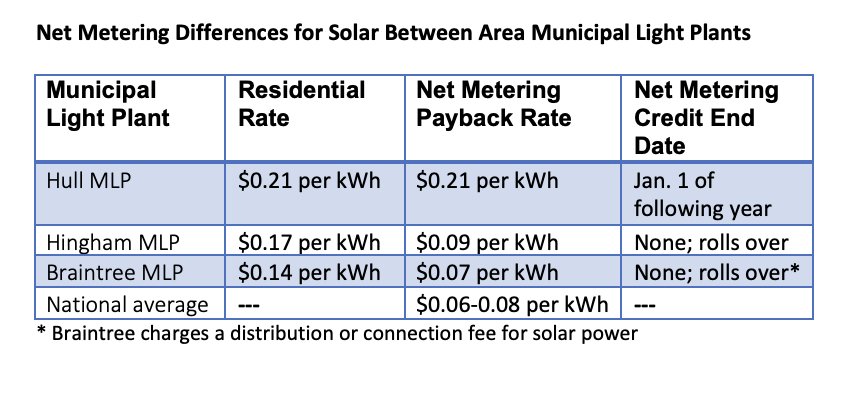Important considerations when deciding whether to add solar panels to your home
/By the Clean Energy Climate Action Committee
If you have a home or business in Hull, and you are considering solar, here is some information that may be useful.
The average U.S. home uses about 30kW hours per day, which translates into about 16 solar panels, or an 8.5kW system (Source: Solar.com). There are plenty of online calculators and resources to help consumers determine how many solar panels or which type of system best suits your needs and budget.
There are federal and state tax incentives for purchasing solar systems. Thanks to the Inflation Reduction Act of 2022, you get 30% of the total cost of your system back in the form of a federal tax credit until 2032 (Source: www.energy.gov/eere).
In Massachusetts, you will receive 15% of the total cost back as an income tax credit of $1,000 per year for up to three years, a $3,000 maximum. This means if you purchase a $20,000 solar system you would actually pay $11,000 after all the tax rebates. Solar panels and associated equipment are sales tax exempt. Plus, you get the net metering and energy savings each year for the life of the system.
Some solar companies provide finance options to reduce upfront costs. However, the Hull Municipal Light Plant (HMLP) does not allow customers to lease solar panels, called Power Purchase Agreements (PPAs). HMLP considers these agreements to be competitive rather than cooperative, so your only option for now in Hull is to buy solar panels.
Owning solar panels allows consumers to benefit from money generated from the excess power they produce by selling it back to the power company via an interconnection agreement. HMLP pays a much higher rate for solar generated electricity than is typical – a generous 21 cents per kWh. This far exceeds the national average of 6-8 cents per kWh. Hull’s rate compares very favorably to surrounding municipal light plants.
For historical context, in 2015 only three homes in Hull had solar power. Today, thanks in part to generous net metering terms set in 2015 by HMLP, 51 homes have solar. While the HMLP limits the size of solar to 15kW, HMLP voted to consider commercial solar installations on a case-by-case basis. The HMLP also raised the cap on maximum production from solar for the town to enable more people to add solar panels.
In Hull, you need to fill out a seven-page application which is available on the light plant’s website. Your installer or electrician and inspector need to fill out part of the form.
Solar systems can be programmed to automatically power up in advance of storms or disconnect from the power grid during power outages. For nights, cloudy days, and backup power during service outages, you can add storage batteries. They can also help to maximize your power output. There are smartphone apps that allow consumers to track how much power you produce and consume, and to adjust the charge level of the batteries. As more batteries come online, Hull’s light plant will explore the possibilities of working with homeowners to utilize those batteries during peak demand hours for peak shaving purposes, which will result in lower prices for ratepayers, and less stress on the grid.
With the net metering payment in Hull at such a high rate and the monthly savings easing your energy bills for the life of the system, solar may be a worthy investment. If the idea is enticing but you have more questions, members of Hull’s Clean Energy Climate Action Committee would be happy to help.
For more information, see Hull2030.com and the Hull Municipal Light Plant website, www.town.hull.ma.us/hull-municipal-light-plant.
Thanks to HMLP for providing rate and other information for this article.
Do you have an opinion on this issue? Click here to write a Letter to the Editor.











